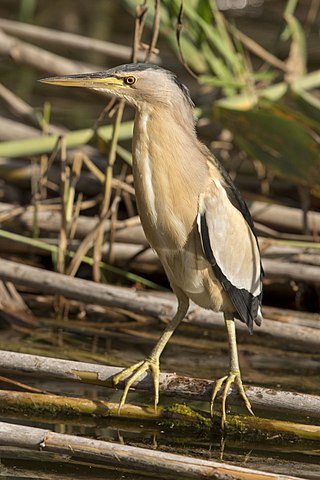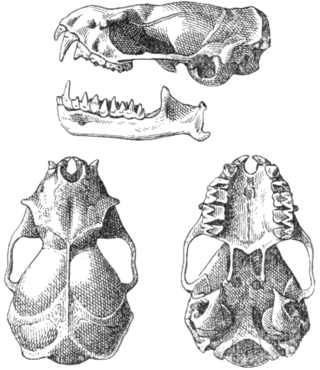Related Research Articles

The little gull, is a species of gull belonging to the family Laridae which is mainly found in the Palearctic with some colonies in North America. It breeds on freshwaters and spends winters at sea. It is the smallest species of gull in the world and the only species in the monospecific genus Hydrocoloeus.

The little bittern or common little bittern is a wading bird in the heron family, Ardeidae. Ixobrychus is from Ancient Greek ixias, a reed-like plant and brukhomai 'to bellow', and minutus is Latin for 'small'.

The little curlew is a wader in the large bird family Scolopacidae. It is a very small curlew, which breeds in the far north of Siberia. It is closely related to the North American Eskimo curlew.

The poor cod is a temperate marine fish belonging to the cod family (Gadidae). It is red brown in colour and has a pronounced chin barbel. It may grow up to a length of 40 cm. It is usually found in small shoals at depths between 10 and 300 metres on muddy or sandy bottoms. Its distribution spans the eastern Atlantic, from Norwegian coasts to Portugal and along the Atlantic coast of Morocco. Spawning takes place towards the end of winter. They are often regarded as a mini species and are commonly confused with pouting as they have a similar appearance. They are often seen as a menace for anglers and have little commercial value and so are not currently at any risk of extinction.

The harvest mouse is a small rodent native to Europe and Asia. It is typically found in fields of cereal crops, such as wheat and oats, in reed beds and in other tall ground vegetation, such as long grass and hedgerows. It has reddish-brown fur with white underparts and a naked, highly prehensile tail, which it uses for climbing. It is the smallest European rodent; an adult may weigh as little as 4 grams (0.14 oz). It eats chiefly seeds and insects, but also nectar and fruit. Breeding nests are spherical constructions carefully woven from grass and attached to stems well above the ground.

Micromys is a genus of small rodents in the subfamily Murinae. The genus contains two living species: the widespread Eurasian harvest mouse of much of Europe and Asia; and the more restricted Indochinese harvest mouse of Vietnam, southern China, and perhaps nearby regions. Fossils of Micromys date back to the Late Miocene and include at least 10 extinct species, which form several lineages.

The black noddy, also known as white-capped noddy, is a species of tern in the family Laridae. It is a medium-sized seabird with black plumage and a white cap that closely resembles the lesser noddy with which it was at one time considered conspecific. The black noddy has slightly darker plumage and dark rather than pale lores.

The Eurasian pygmy shrew, often known simply as the pygmy shrew, is a widespread shrew of the northern Palearctic.

The tiny tuco-tuco is a tuco-tuco species found in Brazil and Bolivia.
Neacomys minutus, also known as the minute neacomys, the small bristly mouse, or the minute spiny mouse, is a rodent species from South America in the genus Neacomys. It is found in Brazil.

The little goblin bat is a species of bat in the family Molossidae, the free-tailed bats. It is endemic to Cuba.
Microryzomys is a genus of rodent in the tribe Oryzomyini of family Cricetidae. It is closely related to Oreoryzomys, Oligoryzomys, and Neacomys. It contains two species, both restricted to the Andes: M. altissimus and M. minutus.
Microryzomys minutus, also known as the montane colilargo or the forest small rice rat, is a species of rodent in the genus Microryzomys of family Cricetidae. It is found in Bolivia, Colombia, Ecuador, Peru, and Venezuela, but these populations may represent more than one species.

The Cape penduline tit or southern penduline tit is a species of bird in the family Remizidae. It is found in Angola, Botswana, Namibia, South Africa, and Zimbabwe. Its natural habitats are dry savannah, subtropical or tropical dry shrubland, and Mediterranean-type shrubby vegetation. At eight centimetres (3 in) in length, it is one of the smallest species of bird found in Africa, along with its cousins the grey penduline tit and the mouse-coloured penduline tit.

The lesser tube-nosed bat is a species of megabat in the family Pteropodidae. It is native to two of the Maluku Islands in northern Indonesia.

The minute fruit bat is a species of megabat within the family Pteropodidae. It is found in Sumatra, Java, Borneo and Sulawesi. The C. minutus is a smaller species that lives in rainforests. Continuous bimodal polyoestry has seasonal reproduction. The females of the species reproduce in synchrony, giving birth to offspring 5-7 months apart throughout two separate seasons. Postpartum oestrus occurs after each parturition. In C. minutus, both sexes reach sexual maturity at around 7 months, and females give birth for the first time at around 12 months. Females start having children not long after reaching sexual maturity, and they effectively continue having children indefinitely. Relative to other fruit bats, C. minutus have high rates of reproduction.
Alamitornis is an extinct genus of basal ornithuromorph bird, possible within the family Patagopterygidae. Remains have been found in the Upper Cretaceous Los Alamitos Formation at Los Alamitos, Río Negro Province, Argentina. It was first named by Federico L. Agnolin and Agustín G. Martinelli in 2009 and the type species is Alamitornis minutus.
Simiolus is an extinct genus of dendropithecid primates. It was described by Mary Leakey and Richard Leakey in 1987, and the type species is S. enjiessi, which existed during the Miocene of Kenya. The species epithet is a phonetic pun on the acronym NGS. A new species, S. andrewsi, also from the middle Miocene of Kenya, was described by Terry Harrison in 2010. In November 2018, scientists reported the discovery of the smallest known ape, Simiolus minutus, which weighed approximately eight pounds, and lived about 12.5 million years ago in Kenya in East Africa.
The Maspalomas bow-legged grasshopper is a species of grasshopper of the family Acrididae. The species is endemic to the town of Maspalomas on Gran Canaria Island, and is considered Critically endangered, or almost extinct, since it hasn't been found since 1949.

Gobiraptor is a genus of oviraptorid maniraptoran dinosaur from the Maastrichtian-age Nemegt Formation of Mongolia. The type and only species is Gobiraptor minutus, known from a single incomplete specimen—the holotype MPC-D 102/111. It has been found not to be closely related to the other oviraptorids it shared its environment with.